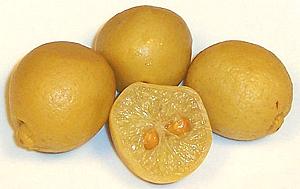Winter is the season for the citrus crops in Israel, and this year the trees are burgeoning with beautiful colorful fruit. We've had a very cold and wet winter so far with more of the same to come. Last week, on a half-sunny-day reprieve from the cold and rain, i took a walk through my neighborhood and discovered what was there all along but too invisible behind the torrents of rain - lemons, and tangerines waiting to be picked, dotting every garden and behind every fence, including my own front yard garden.
The words of the old Peter, Paul and Mary song "Lemon Tree, Very Pretty" say that the fruit of the lemon is impossible to eat. Impossible to eat, unless of course, you live in the Middle East, where Moroccan pickled or preserved lemons are a common condiment at the dinner table, enhancing chicken, fish meals as well as salads.
www.clovegarden.com
Preserved Lemons or Moroccan Pickled Lemons are easy to make. There are several approaches - pickling them in lemon juice and salt, pickling them in oil and salt, or heating/cooking the lemons and then pickling. Most recipes take about a month to cure, require a sterilized jar, but others need only a few days. I will provide recipe for two different methods.
My friend Talia makes a short version with the oil, not requiring the sterilized jar, producing a tart, firm condiment as opposed to the sweeter soft lemon of the longer method. In the original recipe, fresh garlic cloves, sliced, and whole red chili peppers were used. Do to the potential for botulism when garlic and peppers are held in oil, I have omitted the garlic and substituted dry flaked chilis for the whole chilis. One may also use other spices such as cinnamon, cloves, coriander or bay leaf. Here is a variation on her recipe.
Pickled Lemon or Limon Kavush ala Talia
 1 kilo ripe lemons
1 kilo ripe lemons10 T. coarse salt
5 T. neutral oil (olive oil may be too strong. try grapeseed, almond or safflower oil or half olive & half other oil)
1 canning jar with tight lid. Does not need to be sterilized.
Spices: choose from cinnamon, cloves, coriander, bay leaf, dried chili pepper or flakes, black pepper.
Wash lemons well, slice into medium slices.
Layer slices of lemon into jar, pressing down to compact them
Every 2 layers sprinkle 1 T salt over the lemons
Every 3 layers spread or sprinkle spices over the lemons
When the jar is filled and lemons compressed, add the 5 T. of oil completely covering the lemons.
Close lid and let stand overnight in a dark place. The following day turn the jar upside down shaking it to redistribute the juices and oil. Let stand another 24 hours. Refrigerate.
May be used for up to 2 weeks.
Nice Perk: When lemons are ready to use separate out 1/2 of the jar's contents and blend in a food processor to create a paste or spread. It can be kept separately and used in cooking or returned to the jar and the entire contents served as a relish or also in cooking. (tangine, fish, chicken)
Recipe w/ Lemon & Salt
This recipe from www.clovegarden.com uses only lemons, salt and spices. It is also very easy but takes a month to cure producing a soft preserved lemon. It can be used for up to a year (as opposed to 2 weeks). Enjoy.
Making Preserved Lemons
|





































